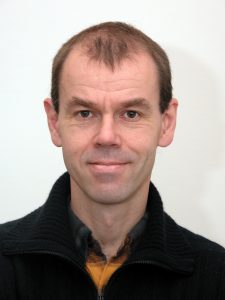
Thomas Schimmang
Investigador científico CSIC
Laboratorio C8
correo electronico: schimman@ibgm.uva.es
Tel: 983184818
Linea de Investigación:
La perdida de la audición es uno de los defectos principales que afecta especialmente las poblaciones de los países industrializados. Se puede producir por la exposición a ruido, un daño directo o heredada genéticamente con 1 en 1000 recién nacidos afectados. Sin embargo, especialmente en los países industrializados la exposición a medicamentos (p.e. aminoglucosidos para el tratamiento de infecciones severas) y el numero creciente de individuos con una edad avanzada ha resultado en un incremento de la perdida crónica de la audición. La perdida de la calidad de vida en las personas afectadas y los costes asociados para el diagnóstico y el tratamiento de los pacientes es una considerable carga social y económica para nuestras sociedades.
Nuestro interés se centra en diversos aspectos fisiológicos del órgano auditivo como son su desarrollo e inervación, procesos fisiopatológicos involucrados en la lesión y la degeneración de las neuronas auditivas y las células ciliadas y la transferencia génica en el oído interno. Al nivel molecular nos hemos concentrado en las neurotrofinas y sus receptores, los factores de crecimiento de fibroblastos (FGFs) y diferentes factores de transcripción (myc, otx2, meis2). El análisis funcional de estos genes se realiza in vivo mediante ratones transgenicos. Estos experimentos se complementan con estudios in vitro usando cultivos de células ciliadas y neuronas auditivas. Realizamos tanto experimentos de ganancia de función (expresión vírica, ratones transgénicos) como de pérdida de función (ratones knock-out). Recientemente hemos introducido nuevas líneas de investigación que se dedican a diseñar protocolos para curar la perdida de audición mediante terapia celular o génica.
Miembros del Grupo:
- Dr. Beatriz Duran
- Iris López-Hernández
Publicaciones relevantes:
J. Neurosci Res. 2019 Oct 30. doi: 10.1002/jnr.24544. Online ahead of print.
Sci Rep. 2019 Feb 20;9(1):2410.
Development. 2019 Feb 1;146(3).
BDNF-Live-Exon-Visualization (BLEV) Allows Differential Detection of BDNF Transcripts in vitro and in vivo.
Singer W, Manthey M, Panford-Walsh R, Matt L, Geisler HS, Passeri E, Baj G, Tongiorgi E, Leal G, Duarte CB, Salazar IL, Eckert P, Rohbock K, Hu J, Strotmann J, Ruth P, Zimmermann U, Rüttiger L, Ott T, Schimmang T, Knipper M.
Front Mol Neurosci. 2018 Sep 27;11:325.
Visualizing BDNF Transcript Usage During Sound-Induced Memory Linked Plasticity.
Matt L, Eckert P, Panford-Walsh R, Geisler HS, Bausch AE, Manthey M, Müller NIC, Harasztosi C, Rohbock K, Ruth P, Friauf E, Ott T, Zimmermann U, Rüttiger L, Schimmang T, Knipper M, Singer W.
Front Mol Neurosci. 2018 Jul 31;11:260.
PLoS One. 2018 Jul 6;13(7):e0200210.
Gαi Proteins are Indispensable for Hearing.
Beer-Hammer S, Lee SC, Mauriac SA, Leiss V, Groh IAM, Novakovic A, Piekorz RP, Bucher K, Chen C, Ni K, Singer W, Harasztosi C, Schimmang T, Zimmermann U, Pfeffer K, Birnbaumer L, Forge A, Montcouquiol M, Knipper M, Nürnberg B, Rüttiger L.
Cell Physiol Biochem. 2018;47(4):1509-1532.
PLoS Genet. 2016 May 4;12(5):e1006018. doi: 10.1371/journal.pgen.1006018. eCollection 2016 May.
Mol Neurobiol. 2016 Oct;53(8):5607-27. doi: 10.1007/s12035-015-9474-x. Epub 2015 Oct 17.
J Anat. 2016 Feb;228(2):255-69. doi: 10.1111/joa.12376. Epub 2015 Sep 25. Review.
Development. 2015 Aug 15;142(16):2792-800. doi: 10.1242/dev.122465. Epub 2015 Jul 9.
Neuroscience. 2014 Dec 26;283:26-43. doi: 10.1016/j.neuroscience.2014.07.025. Epub 2014 Jul 24. Review.
Dev Neurobiol. 2014 Jun;74(6):643-56. doi: 10.1002/dneu.22162. Epub 2014 Jan 16.
Front Mol Neurosci. 2013 Aug 9;6:20. doi: 10.3389/fnmol.2013.00020. eCollection 2013.
Semin Cell Dev Biol. 2013 May;24(5):507-13. doi: 10.1016/j.semcdb.2013.04.004. Epub 2013 May 9. Review.
Regen Med. 2012 Nov;7(6):769-83. doi: 10.2217/rme.12.65.
Hear Res. 2013 Mar;297:84-90. doi: 10.1016/j.heares.2012.11.001. Epub 2012 Nov 14. Review.
Mol Neurobiol. 2013 Feb;47(1):261-79. doi: 10.1007/s12035-012-8372-8. Epub 2012 Nov 16.
Mech Dev. 2013 Feb;130(2-3):160-8. doi: 10.1016/j.mod.2012.09.009. Epub 2012 Oct 4.
J Neurosci. 2012 Jun 20;32(25):8545-53. doi: 10.1523/JNEUROSCI.1247-12.2012.
Adv Exp Med Biol. 2012;741:89-102. doi: 10.1007/978-1-4614-2098-9_7
Histol Histopathol. 2011 Jul;26(7):923-40. doi: 10.14670/HH-26.923. Review.
N-myc controls proliferation, morphogenesis, and patterning of the inner ear.
Domínguez-Frutos E, López-Hernández I, Vendrell V, Neves J, Gallozzi M, Gutsche K, Quintana L, Sharpe J, Knoepfler PS, Eisenman RN, Trumpp A, Giráldez F, Schimmang T.
J Neurosci. 2011 May 11;31(19):7178-89. doi: 10.1523/JNEUROSCI.0785-11.2011.
Cell Mol Life Sci. 2011 Aug;68(16):2739-49. doi: 10.1007/s00018-010-0586-1. Epub 2010 Nov 15.

